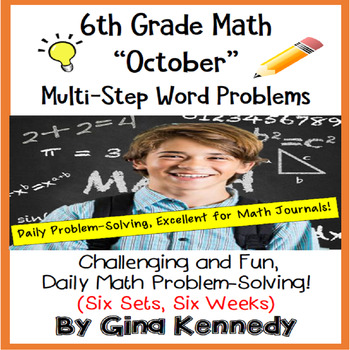6th Grade October Daily Problem Solving: Math Challenge Problems (Multi-Step)
- PDF
- Easel Activity
Also included in
- PDF or Digital Option! BUNDLE! 6th Grade Math Multi-Step Daily Problem-Solving Practice, 58 sets (five problems in each set), 290 Multi-step Problems! Ten months of standards aligned multi-step problem solving word problems. The problems in this resource are research driven to promote the type ofPrice $19.99Original Price $29.00Save $9.01
Description
Six sets (five in each set) of standards-based October themed 6th Grade math daily problems. Great for no-prep "daily" problem solving or for use anytime as an entire set. Most of the problems require multiple operations and are excellent for math journals. The problems involve all mathematical concepts including algebra, fractions, decimals, geometry, measurement and more. This resource is intended to provide students with the opportunity to practice daily computations and word problems that involve real world situations. Great test-prep for standardized math exams.
Works perfectly for distance learning as well!
Meets NCTM Standards! The problems included with this resource match the standards in most 6th grade curriculum including CCSS and STAAR! The problems in this resource will add the daily reinforcement your students need to strengthen their critical thinking skills.
Each set includes one bonus problem in which students must solve the problem using real life (no research) data. Your students will find these problems challenging and fun!
All new products in my store are 50% off the first 24 hours. Be sure to follow my store above to receive notice within the first 24 hours that new products are listed.
For more 6th grade math problem solving resources, click on the individual resources below:







